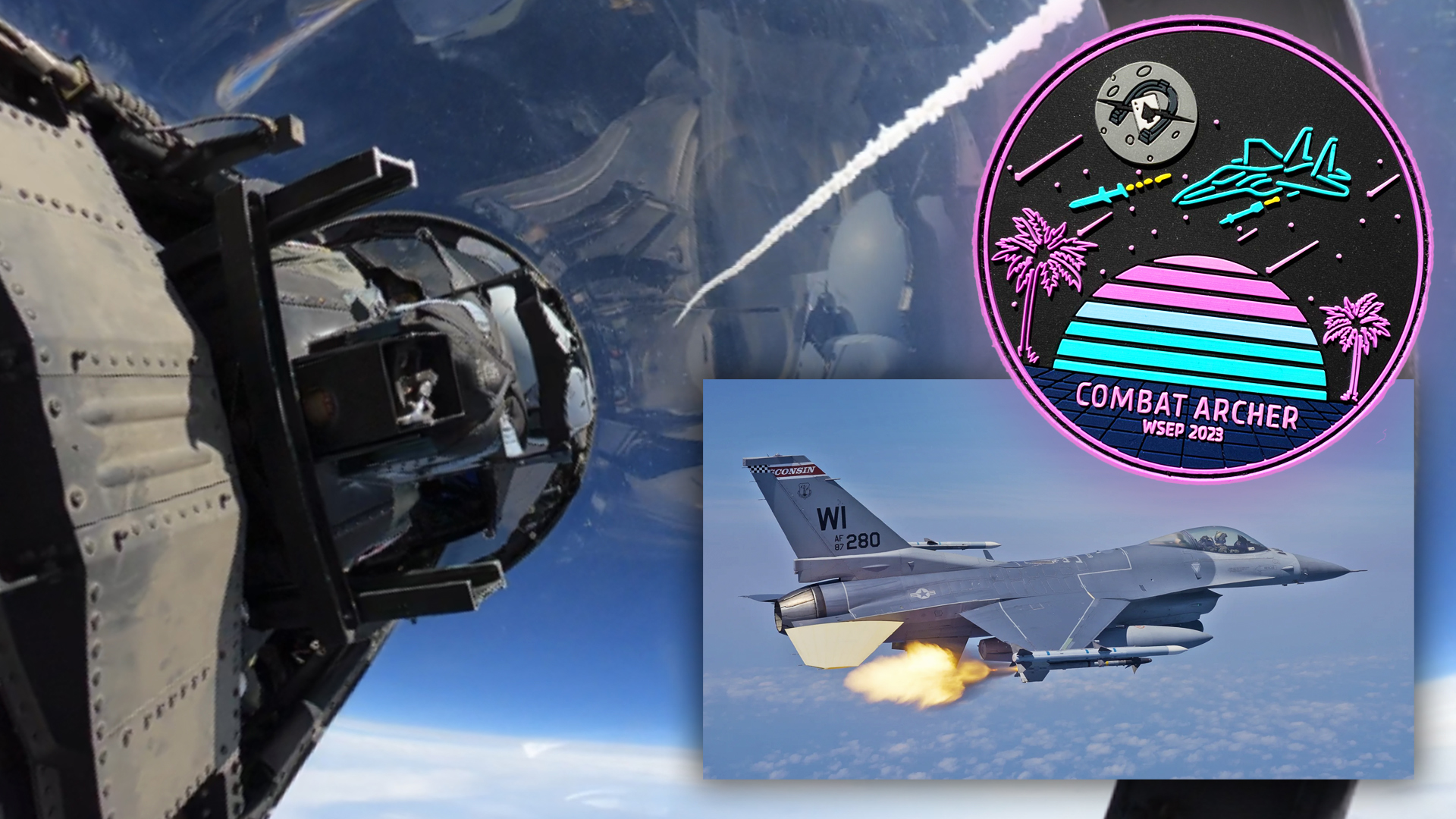“Aces 11, bandit bandit!” A surge of radio calls identify the target, and make sure the jet that is about to unleash a live missile is locked-up on the correct one. In the F-15D chase aircraft, “Monster,” my pilot, is working hard. We have been cleared to chase the shooter as we barrel down from our holding altitude. Leveling out, we come alongside the F-16. Monster exchanges a final volley of calls with the task-saturated shooter. He’s the reassuring voice, coaching this first-time missile firing fighter pilot through the final steps. “Hostile, clear to fire!” Then come the final words of “FOX! FOX!” The missile streaks away.
All the work that goes into exercise Combat Archer — the U.S. military’s largest live air-to-air missile firing event — culminates in a handful of frantic moments just like this.

Editor’s Note: Welcome to the fifth and final day of WSEP Week at The War Zone. Each day this week we have posted a major feature on the Pentagon’s biggest air-to-air live fire exercise that works to ensure the weapons, tactics, and people that give it an edge over its adversaries will all work as they are supposed to in a real fight.
It’s 6:00 am. The deep orange sun is slowly cresting the tree line to the east of Tyndall Air Force Base in Florida, and the dawn mist is starting to evaporate. The still of the morning air is broken by the distant thump of generators as activity on the Combat Archer flight line grows.
First light brings with it the various maintainers from the visiting F-15, F-16, F/A-18C/D, and F-35A squadrons. Before the day’s humid heat builds, they are already working hard, loading missiles allocated to specific jets for the morning Combat Archer ‘go.’ The loading is done under the watchful gaze of evaluators from the resident 83rd Fighter Weapons Squadron (FWS), who are taking careful notes and advising the load crews so that they get the weapons loaded up exactly right.
Most of the missiles here at the U.S. Air Force’s Weapons System Evaluation Program (WSEP) carry telemetry kits, and each weapon is paired to a specific jet so that when the action unfolds the experts tracking the data know exactly who has shot what, how they have fired it, and what the intention was. Final checks are made as the last AIM-9X Sidewinder heat-seeking missile is loaded — and the maintainers retreat to the air-conditioned sanctuary of the trailers adjacent to the flight line.
The jets are ready to go.
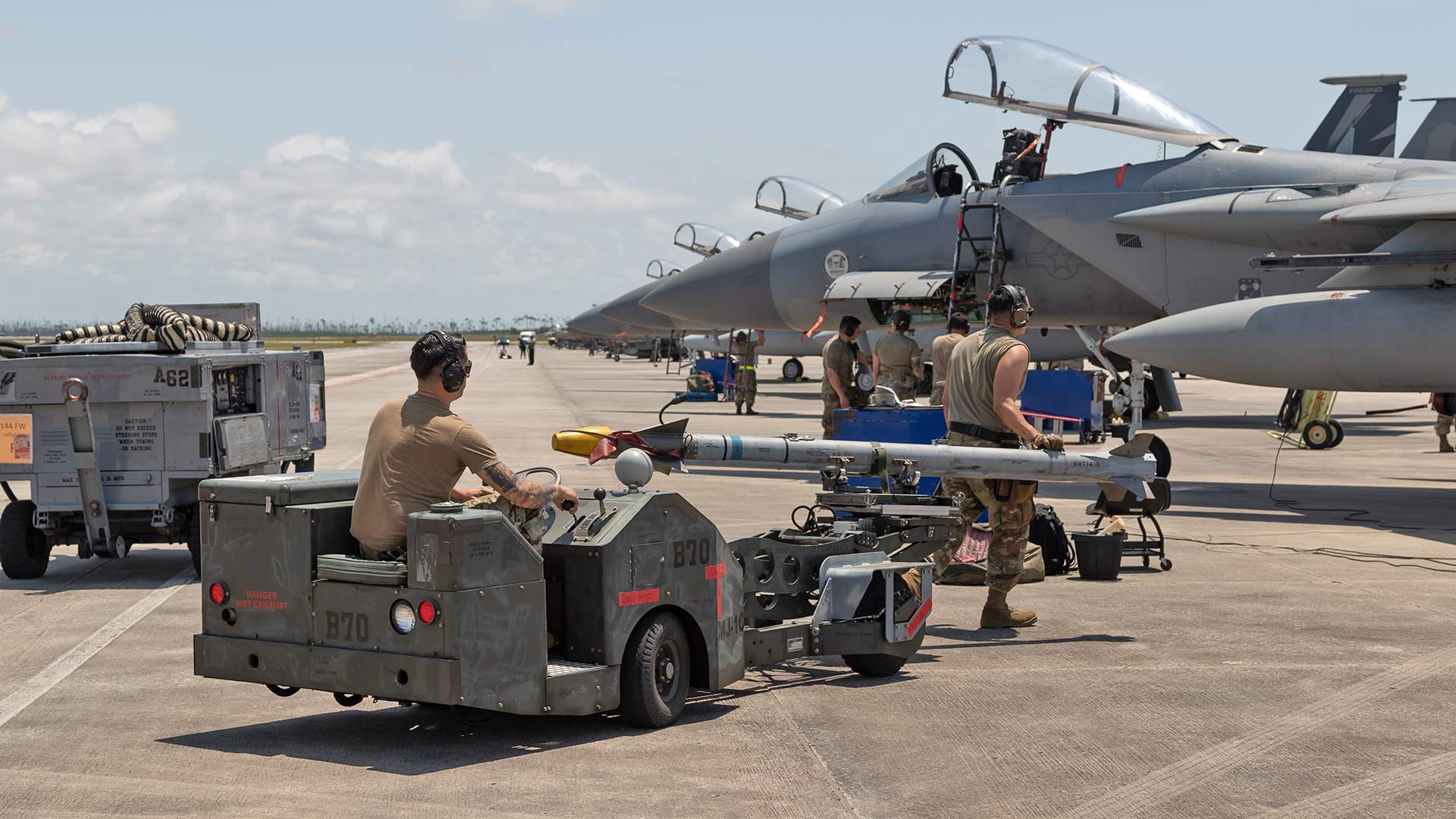
Meanwhile, inside the 83rd FWS, the ground mission commander — known as the Pit Boss — is photocopying mission cards, checking updated details, and getting ready for the agency brief. It’s 7:00 am.
The agency brief brings together the key players for the morning’s activities. The 81st Air Control Squadron (ACS) manages the airspace, Wetstone range controllers talk to the pilots throughout the mission, the 82nd Aerial Targets Squadron (ATRS) is responsible for the drones that will be fired at, and then there are the operations teams from the various participating squadrons. They cover the general plan for the day and field any last-minute questions about drone plans, airspace considerations, weather, and similar.
After a short break comes the mission briefing, attended by all aircrew allocated to fly today. The mission flow calls for the first formation of jets to launch as a mix of F-15C, F-16C, and F-35A fighters. These will be the first to fire this morning and they are each carrying a telemetry-equipped AIM-120D Advanced Medium-Range Air-to-Air Missile (AMRAAM) and are assigned to shooting at a QF-16 Full-Scale Aerial Target.

Overall, the “go” on today’s mission consists of four F-15s, six F-16s, and eight F-35s, all of which are using the “Aces” radio callsign. Each element — pairs or four-ships — includes an 83rd FWS pilot program manager (PM), who will act as either a shooter, or a chase platform for the shooters, or both. As the aircrew arrive in the briefing room they are all met by the Pit Boss who distributes mission paperwork and will run the show today aided by fellow 83rd FWS PMs.
Once the general flow of the mission is briefed, the Pit Boss runs through the missile and drone allocations for each shooter and then talks through the specific planned shot profiles. “Our shot profiles are all pre-briefed,” explains Maj. Arson, the director of operations at the 83rd FWS. “If they are shooting an AIM-9X in this WSEP, we’re shooting them all “combat free” — this means they are firing during a profile to represent a two-circle BFM [basic fighter maneuvers] fight. This is driven by what the AIM-9X analysts and the PMs want to see. They have a specific flare program on the drone, so those shooters are going to be set up for that shot profile already knowing exactly how and when they need to hit the pickle button. We have multiple profiles but we give them a specific profile to fly on each mission.”
While the shot profiles are all pre-briefed and set for each aircraft involved in the mission, there are a lot of variables on a Combat Archer mission.
“We need to be very flexible,” explains Arson. “If it’s a sunny clear day and it all flows well, then it can be reasonably straightforward. But typically there are pop-up factors that mean we need to do a lot of planning and hold a lot of contingency options. The tanker can drop out, we might struggle to find a shoot track [due to weather or unscheduled boat traffic], jets can break, the drone might be delayed or not work as planned.”
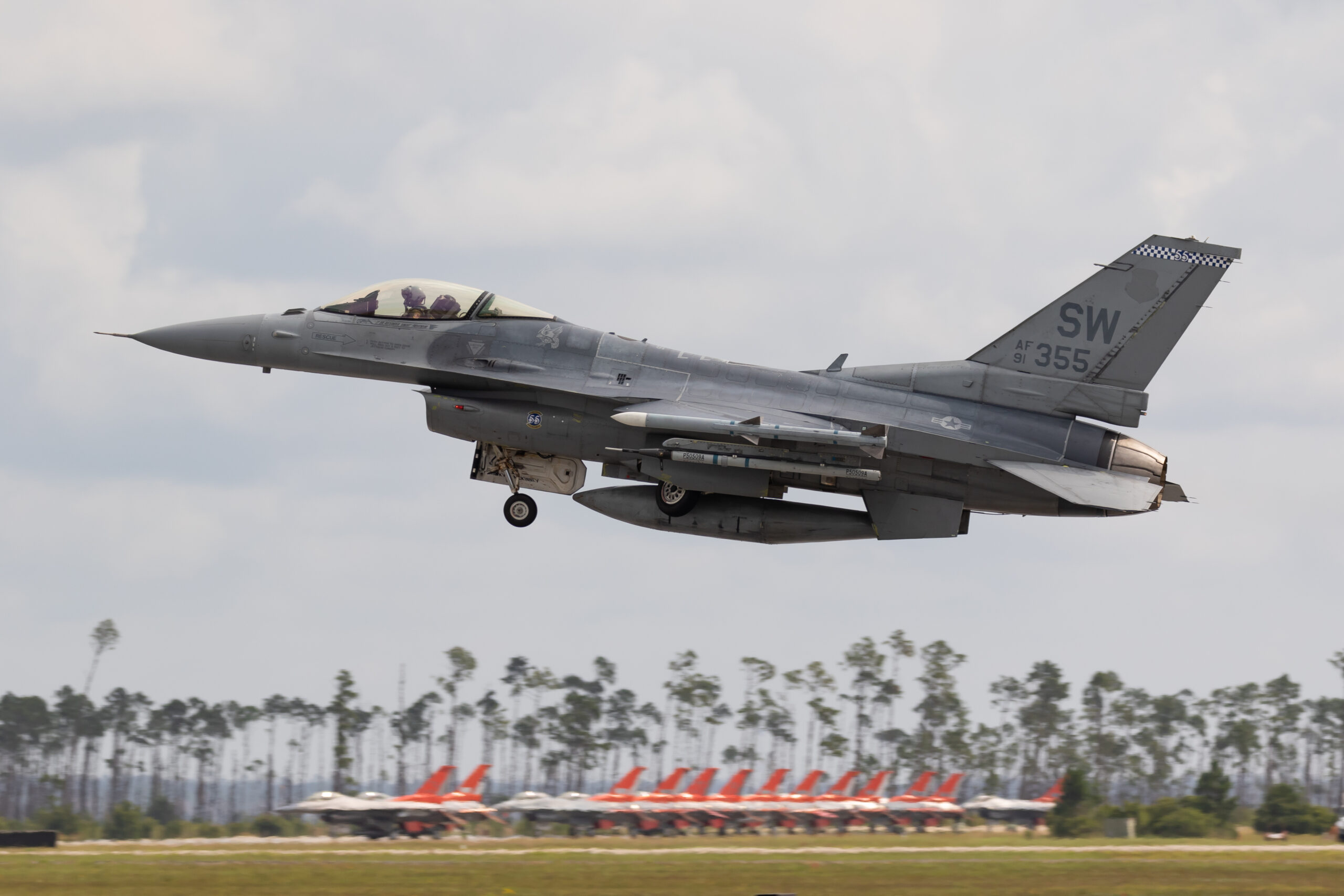
“Ultimately, the shooter needs to be in the right place, at the right time, in VFR [visual flight rules, clear of cloud] conditions because they have to have a safety chase jet alongside in formation. That will be a PM in any jet type — any MDS [Mission Design Series, jet type] can chase any MDS. The only exception is that some experienced test pilots don’t have a mandatory chase.”
With the aircrew briefing complete, the crews head back to their respective squadron enclaves, often chatting excitedly about what they are getting to fire today. Meanwhile, the WSEP wheels are spinning into motion.
The first sign of an impending WSEP mission is that one of the pair of E-9 Widgets, assigned to the 82nd ATRS, takes off from Tyndall. The Widget, working with the 81st ACS, must conduct a range safety patrol. It will datalink details or provide bullseye references of boat positions to the range safety officers, who can then plot those around a footprint of the missile shots, to build a suitable shot track in the range complex. If there’s a boat in the way, they have to plot a new track — they don’t and cannot ask the boats to move. Then they start clearing out the airspace.
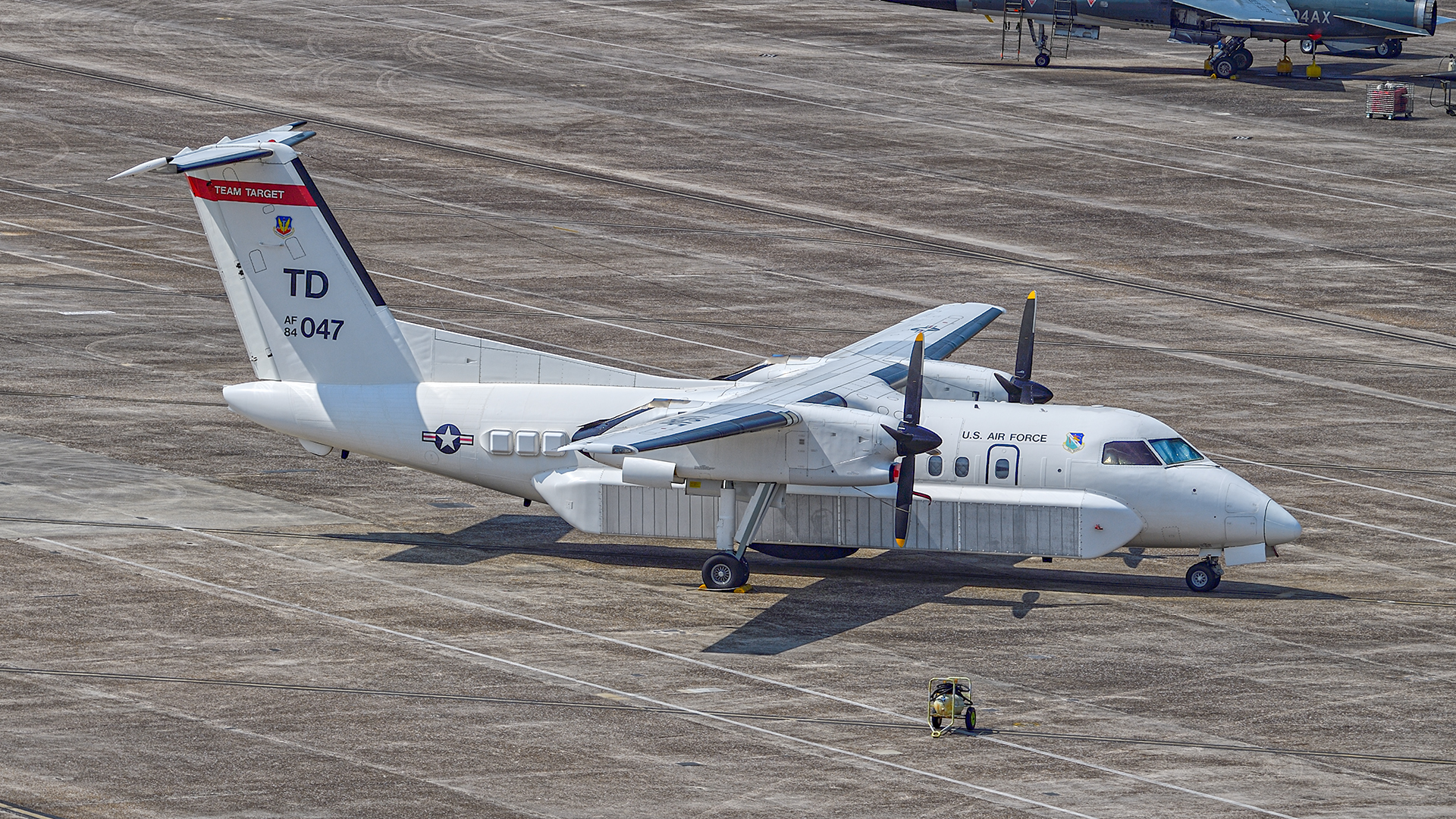
“The E-9 Widget fleet consists of two Dash 8s that are modified for the WEG mission in the Whiskey 151 airspace for the WSEP role,” explains TSgt. Eric Huster, an E-9 evaluator mission systems operator with the 82nd ATRS. “We fly with a crew of four — two pilots, one telemetry, and one radar operator. It’s our job to conduct sea surveillance and help build a container for safe missile fires and for the drones. We also collect and relay the telemetry data from the missiles and drones in real-time to the ground station here at Tyndall and at Eglin.”
“We have an APS-143 surveillance radar in the E-9 and it’s wildly accurate. We gather the information on surface tracks and HF downlink it to the Range Safety Officer [RSO]. They use a footprint for each missile and build a safe container for fighters to shoot inside of. We then continue to monitor vessels around the container. If they infringe the container, we ceasefire or shift the container. We broadcast on marine guard frequencies to let boaters know what we are doing, and they enter the range areas at their own risk, but they are still allowed to do as they please — we have to shoot around them.”
“In the E-9 we can also track slow-moving aircraft, but we only pass that information to the Wetstone controllers at the 81st ACS, we only coordinate on the surface activity.” The E-9 takes off roughly an hour before the first drone launch — so they have around an hour to clear the range and help build the shoot track. Once the RSO has built the track, the coordinates are passed to the fighters and they can start to launch, with the E-9 proceeding to a safe holding position.”
“There are times when drones get hit and we have to go and find them,” says Huster. “The drones have a drogue chute that’s supposed to deploy when they get hit, and our job is to find them and direct our 120-foot missile retriever boats to recover them.”
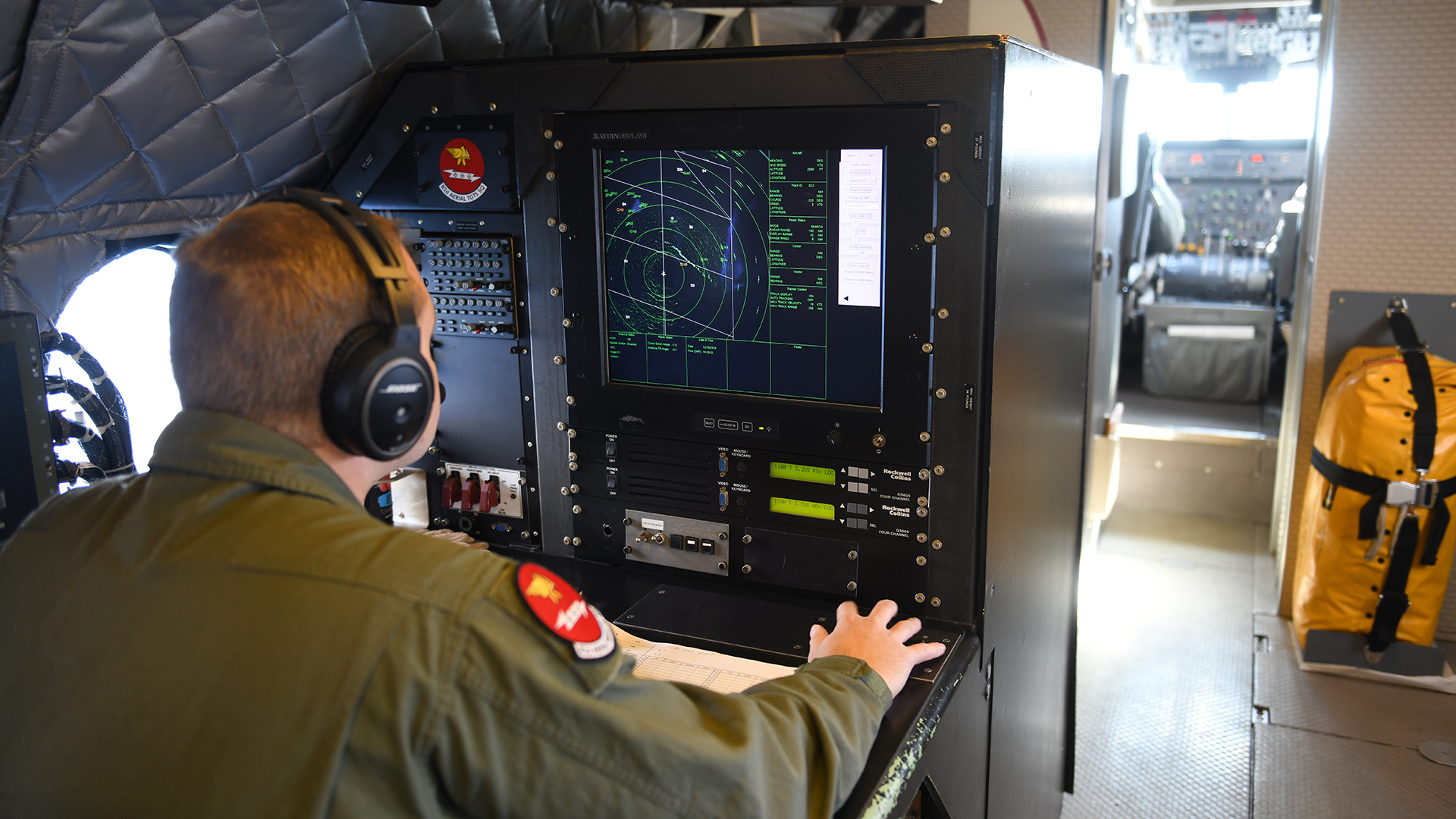
“While the E-9 is responsible for locating and identifying boats, our task is to construct the shooting trajectory to ensure the safety of missile launches,” explains Lt. Col. Quincy Boles, 81st ACS Director of Operations. “This way, we prevent any potential accidents such as a missile falling onto a cargo ship or a cruise ship. Essentially, we oversee and control the entirety of the airspace within the Gulf Range Whiskey zone.”
“In addition, we have AN/TPS-75 long-range air surveillance radars situated 50 miles south of Tyndall. We’re planning to enhance our command and control infrastructure by incorporating more Link 16 datalinks, as an addition to our current radios. This would allow us to establish a digital connection with the fighters and deliver updated instructions through text messages for executing their shots in the future.”
“We are the command and control for the mission, dictating the execution. Our responsibilities include guiding the drone along the shoot track safely, and ensuring it doesn’t pass over boats. We also orchestrate the fighter jets’ departure from the holding point, positioning them for a safe shot at their intended range from the drone. Each fighter jet is held individually in a combat air patrol (CAP) formation, and we alert them when their target drone is airborne.”

Back on the ground at Tyndall, the fighters’ engines are running, and the series of flights of jets have started making their way to the arming area at the end of the runway in the flow pattern of the overall mission. Maj. “Monster” is flying in the first formation in F-15D callsign “Aces 11,” with the author in the back seat. Monster is an 83rd FWS F-15 PM, and will chase a number of shots today. Two F-16s and two F-35s taxi up and park alongside the F-15 — they are all carrying live AIM-120Ds. The F-15D is also carrying a live AIM-9. This would only be used today if the drone became uncontrollable and could not be terminated. The Eagle could be called in to “splash” the drone.
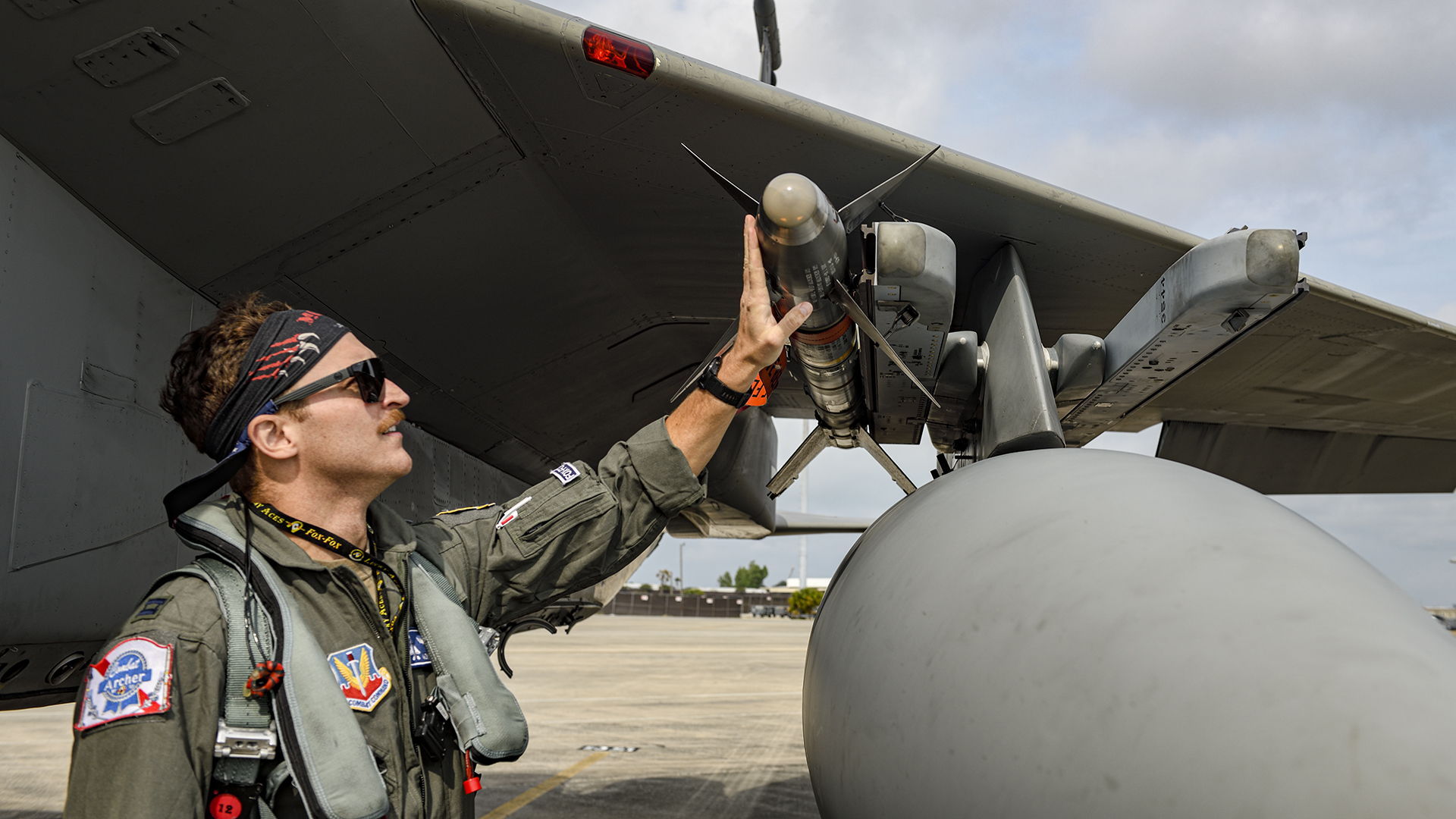

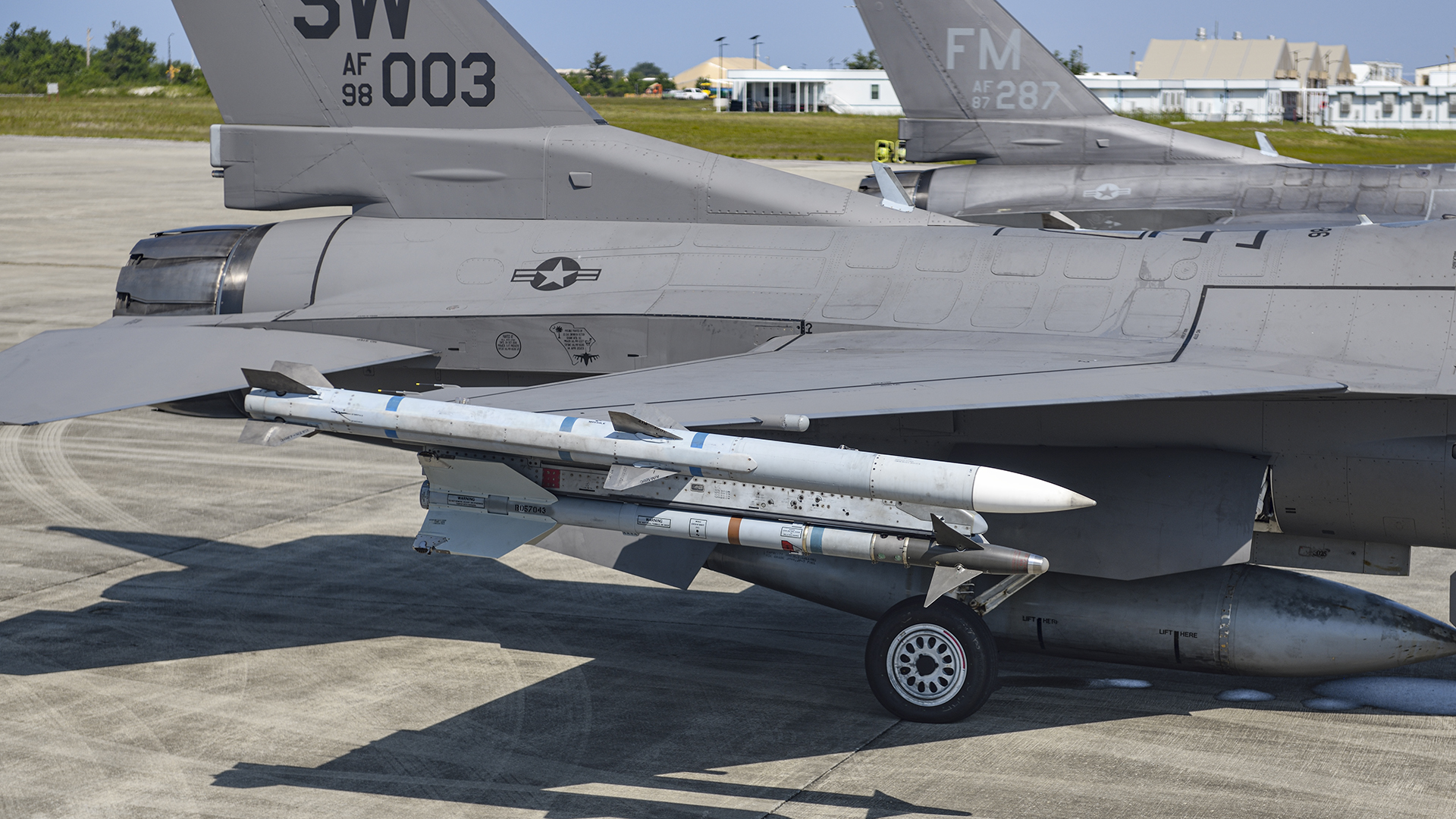
With the first shooters at the holding point, the RSO passes the “words” to the pilots; this relates to the shoot track and signals that the WSEP mission is a go!
The fighters launch and proceed as directed by Wetstone range control to respective hold points. Most fighters will be vectored individually for their shots, but some may fire in a pair profile.
Having been granted a very rare and privileged opportunity by the 53rd Wing and Air Combat Command to fly on a Combat Archer mission, it provided me with an unparalleled insight into the complexities of this live missile exercise. I had a decent idea of what was involved, but seeing it for real really opened my eyes to just how complex these missions really are.
The flying portion of a Combat Archer mission begins with relative calm. The first set of shooters and the chase aircraft are airborne and in the range complex. Flying in Monster’s back seat in the F-15D we are flying a gentle racetrack hold in the “fighter CAP” [Combat Air Patrol] listening to the various blasts of communication from Wetstone. I can hear that Monster is already being allocated to an AIM-120D-equipped F-16C from the 55th Fighter Squadron, callsign “Aces 32,” which is first up to shoot at the QF-16.

Monster calls Wetstone to clear the F-15D out of our holding height to be vectored to meet “Aces 32” as it’s being set up for the first shot, known as a “pass.” The relative calm of the departure from Tyndall and the initial flight out to the holding point is suddenly and dramatically traded for the adrenaline and compressed timeline of joining on the F-16, as its pilot sets up for the shot.
We are cleared in, and Monster reefs the big Eagle into an aggressive descending turn towards the emerald waters below – we have been vectored onto the Viper and need to get there fast. Monster already has a visual on the F-16, but I’m nowhere near his level of situational awareness. “Are you ready,” he asks me? I’m fighting the g-forces, desperately straining to get my eyes onto the F-16 out there in the blue, knowing that it’s going to be loosing off its AMRAAM very soon. Not only is he checking if I’m ready to get the shots, but he’s also safely tucking the jet into formation, all the while talking the Viper driver through the final pre-shot checks.
Although there’s a lot of shooters in the air today, there’s at least four chase jets, so we will only get to see a few of the actual shots.

The radio communication between the pilots and the Wetstone controller takes up the story from here.
A call of “cleared to pair” is initiated by Monster in our chase F-15D “Aces 11” to get everyone on the same page. The shot is on!
Aces 11: “Wetstone Aces 11, cleared to pair Aces 32 on a Foxtrot 1 [shot profile] chased by Aces 11.”
Wetstone: “Aces 11 Wetstone, cleared to pair Aces 32 on a Foxtrot 1 chased by Aces 11, Aces 32 check tapes on.”
Aces 32: “Aces 32 check tapes on.”
Wetstone: “Aces 32 reference IP [initial point], fight’s on!”
Wetstone: “Aces 32, single group bullseye, 069/69, angels 20, bogey, Aces 32 commit.” [The target is located 069 degrees and 69 miles from a pre-briefed “bullseye” position at 20,000 feet, it’s hostile, you are clear to engage].
[Wetstone giving the “commit” call indicates the shooter is within the weapon safety footprint regarding boats; this gives the chase pilot permission to arm the shooter hot].
Aces 11: “Aces 32 arm hot.”
Aces 32: “Aces 32 arm hot.”
Aces 32: “Aces 32 targeted bullseye, 069/69 20,000.”
Wetstone: “Aces 11, bandit bandit.”
[The shooter must call targeted with a bullseye. Once that call is made and range safety ensures that is the correct target, they give permission to Wetstone to pass the “bandit bandit” call to the chase pilot. Once the “bandit bandit” call is given to the chase, the chase now owns the Hostile Cleared to Fire (HCTF) call].
Aces 11: “Aces 11 copies bandit, Aces 32 hostile cleared to fire.”
Aces 32: “Aces 32 hostile cleared to fire.”
[At this point it is up to the shooter to employ in accordance with their unique shot profile; the chase will monitor and make sure they do not exceed the max shoot altitude for that day. The “hostile, clear to fire” radio call means that the missile could go at any second. We are alongside, I am ready with the camera]
Aces 32: “FOX! FOX!”

[The missile tears off the launch rail. Suddenly, with a faint whoosh sound, it’s gone in a flash. My GoPro camera picked up the actual sound of the rocket motor as the missile left the rails. The only sign of its path is a thin white trail that disappears into the distance. Often, for the shorter-range AIM-9 shots, the pilots will see the drone and watch the missile tracking it, but the long-range AIM-120s ply their trade beyond visual range.
If the missile passes the target closely but does not directly contact it, telemetry (TM) will pass a “Millertime” call. If the missile impacts the drone, the drone pilot will say “Clear the drone,” which is an alert to the chase that the drone was struck and there will be debris falling. The chase will then respond, “drone is clear,” and if necessary, direct the shooter to check away from the falling debris].
TM: “Millertime.”
Aces 11: “Aces 32 knock it off, arm safe.”
Aces 32, “Aces 32 knock it off, arm safe.”
Both the shooter and chase return as vectored by Wetstone to their respective hold points and the next shooter and chase are readied.

As Monster cruises out to the KC-10 tanker to top up on gas, the next shooters are being called onto their respective drones. We’ve taken enough gas, and our F-15D is soon vectored to pair with another F-16 for an AIM-9M Sidewinder shot, and despite a three-hour mission, it’s all over in what feels like no time at all.
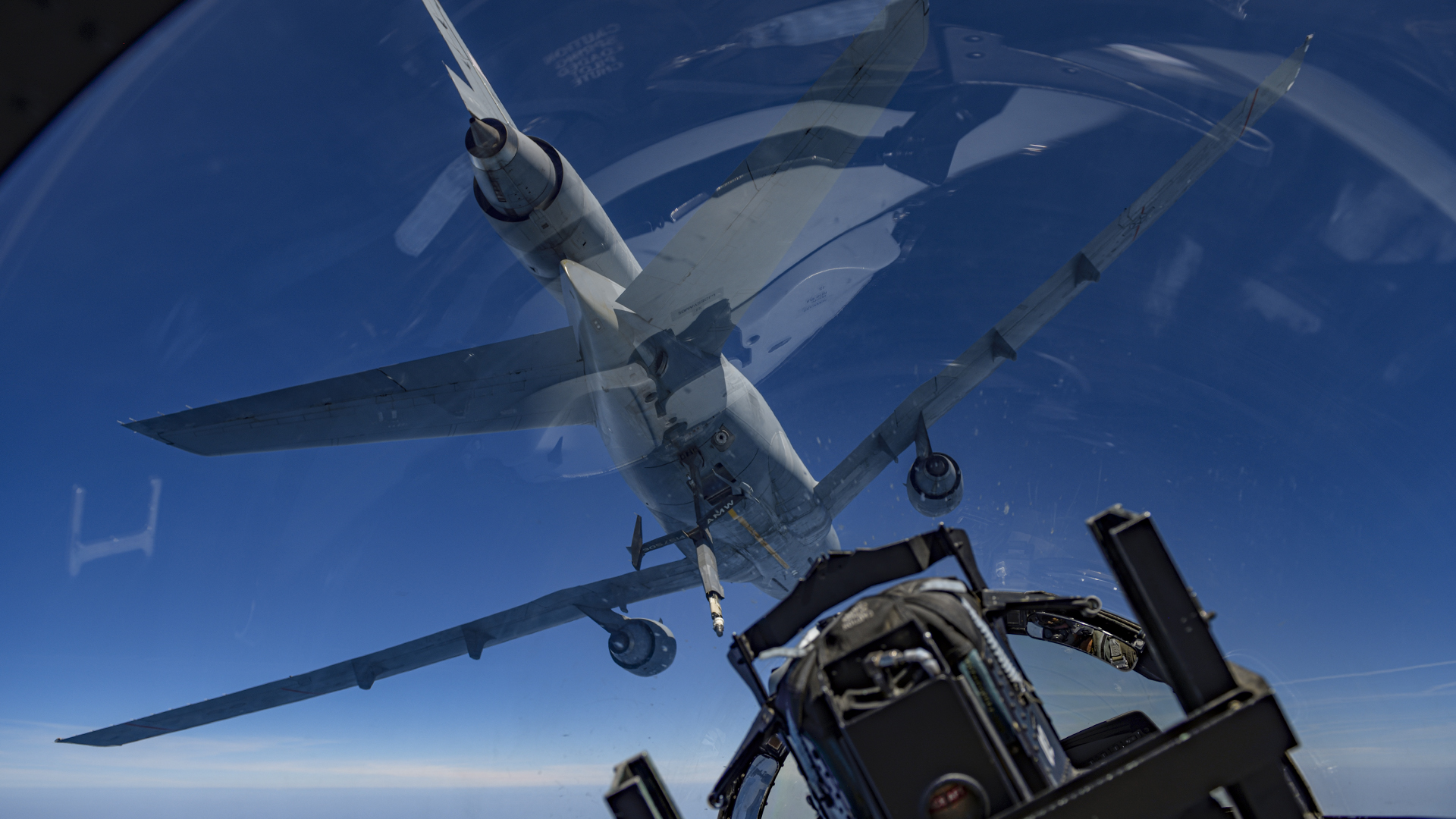


Maj “Demon” picks up the story on this particular mission. “While flying the FSAT [Full-Scale Aerial Target] absolutely adds complexity to the live fire, it is just another procedure that the 53rd WEG executes. On this mission, the QF-16 was physically downed by a direct hit from an AIM-120 fired from an F-35.”
“Just like at any military exercise, we practice operational security to protect capabilities. All the missiles shot, and aircraft flown in Combat Archer are in-service standard; at WSEP we evaluate the current capabilities that would be deployed to a combat situation if that decision was made. To do this, we develop shot profiles to gather data on very specific desired learning objectives. Sometimes while a shooter is down track, one of the many variables [aircraft, aircrew, drones, etc.] don’t meet the requirements for the profile. In that case, we do not want the shot to occur, and we try it again.”
“We strive to make sure every missile shot counts and we can gather the data we are looking for.”

Combining unit readiness training with evaluating live missile shots in a variety of situations underlines how Combat Archer is of huge value to the Air Force. It provides pilots with the real-life experience of actually firing a missile off a jet, plus it offers a litmus test for a fighter squadron to ensure they can actually execute their primary combat mission. This is very important because many of these units would soon deploy after Combat Archer, when they could be called upon to engage another aircraft under real combat conditions.
It also serves to confirm test data on real missiles, proving out what is being fed down the chain from industry and the dedicated test community, or finding new methods of employment or even anomalies that can be raised further up to leadership. Ultimately, Combat Archer is there to ensure when a pilot presses the pickle switch and screams “FOX! FOX!” the missile does exactly what it is supposed to do.
Editor’s note: Our sponsorship partner has no editorial involvement in this article.
Contact the editor: Tyler@thedrive.com
